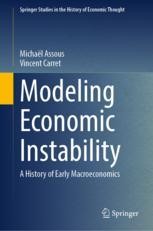
This book offers a fresh perspective on the early history of macroeconomics, by examining macro-dynamic models developed from the late 1920s to the late 1940s, and their treatment of economic instability. This provides a new account of the birth of macroeconomics, away from the usual stories centered around Keynes, and giving back all their breadth to the economic ideas presented by the pioneers of the Econometric Society.
The book first explores the differences and similarities between the early mathematical business cycle models developed by Ragnar Frisch, Michal Kalecki, Jan Tinbergen and others, which were presented at meetings of the Econometric Society and discussed in private correspondence. By doing so, it demonstrates the diversity of models representing economic phenomena and especially economic crises and instability.
Jan Tinbergen emerges as one of the most original and pivotal economists of this period, before becoming a leader of the macro-econometric movement, a role for which he is better known. His emphasis on economic policy was later mirrored in the United States in Paul Samuelson’s early work on business cycles analysis, which, drawing on Alvin Hansen, aimed at interpreting the 1937-1938 recession.
The authors then show that the subsequent shift in Samuelson’s approach, from the study of business cycle trajectories to the comparison of equilibrium points, provided a response to the econometricians’ critique of early Keynesian models. In the early 1940s, Samuelson was able to link together the tools that had been developed by the econometricians and the economic content that was at the heart of the so-called Keynesian revolution. The problem then shifted from business cycle trajectories to the disequilibrium between economic aggregates, and the issues raised by the global stability of full employment equilibrium. This was addressed by Oskar Lange, who presented an analysis of market coordination failures, and Lawrence Klein, Samuelson’s first PhD student, who pursued empirical work in this direction.
By paying attention to the activities of different research groups who built competing models of the economy during this period, this work shows the different use of models: they convey a particular vision of those groups, and contribute to shape the world when they reach policies. By highlighting the various visions and approaches that were embedded in these macro-dynamic models, the book shows that their originality is of interest to today’s model builders interested in the history of their practice, as well as to students and anyone interested in how new economic ideas come to be developed.
This book has been published by Springer in 2022.